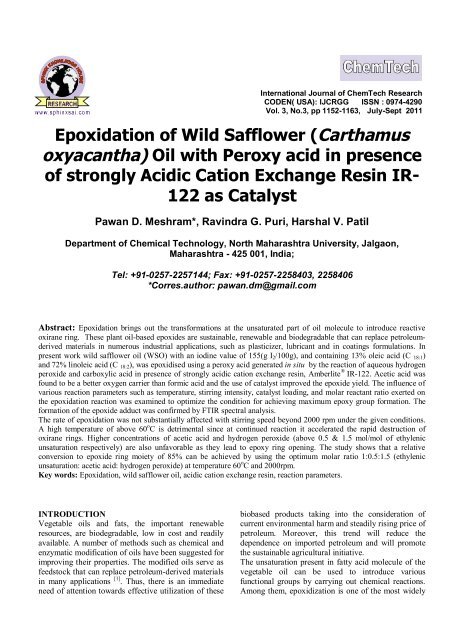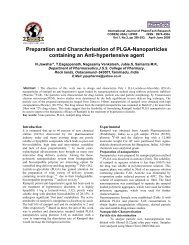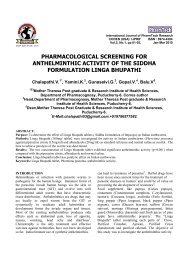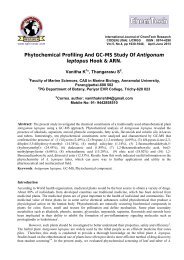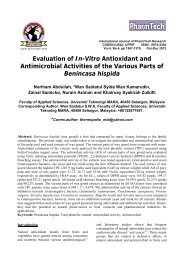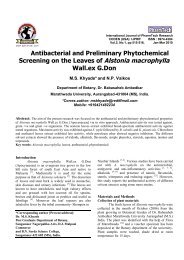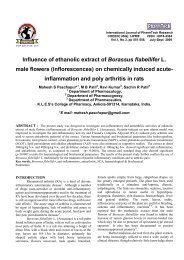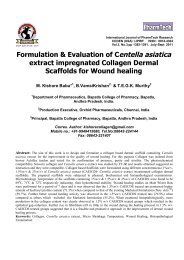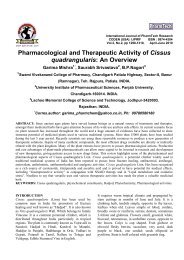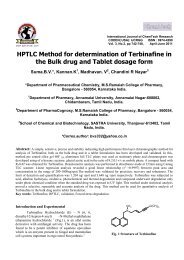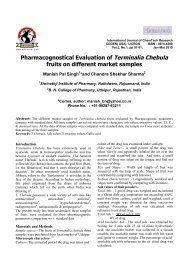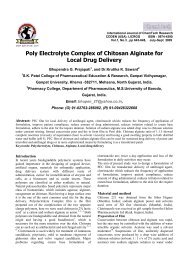epoxidation of wild safflower (carthamus oxyacantha) - Research ...
epoxidation of wild safflower (carthamus oxyacantha) - Research ...
epoxidation of wild safflower (carthamus oxyacantha) - Research ...
Create successful ePaper yourself
Turn your PDF publications into a flip-book with our unique Google optimized e-Paper software.
International Journal <strong>of</strong> ChemTech <strong>Research</strong><br />
CODEN( USA): IJCRGG ISSN : 0974-4290<br />
Vol. 3, No.3, pp 1152-1163, July-Sept 2011<br />
Epoxidation <strong>of</strong> Wild Safflower (Carthamus<br />
<strong>oxyacantha</strong>) Oil with Peroxy acid in presence<br />
<strong>of</strong> strongly Acidic Cation Exchange Resin IR-<br />
122 as Catalyst<br />
Pawan D. Meshram*, Ravindra G. Puri, Harshal V. Patil<br />
Department <strong>of</strong> Chemical Technology, North Maharashtra University, Jalgaon,<br />
Maharashtra - 425 001, India;<br />
Tel: +91-0257-2257144; Fax: +91-0257-2258403, 2258406<br />
*Corres.author: pawan.dm@gmail.com<br />
Abstract: Epoxidation brings out the transformations at the unsaturated part <strong>of</strong> oil molecule to introduce reactive<br />
oxirane ring. These plant oil-based epoxides are sustainable, renewable and biodegradable that can replace petroleumderived<br />
materials in numerous industrial applications, such as plasticizer, lubricant and in coatings formulations. In<br />
present work <strong>wild</strong> <strong>safflower</strong> oil (WSO) with an iodine value <strong>of</strong> 155(g I2/100g), and containing 13% oleic acid (C 18:1)<br />
and 72% linoleic acid (C 18:2), was epoxidised using a peroxy acid generated in situ by the reaction <strong>of</strong> aqueous hydrogen<br />
peroxide and carboxylic acid in presence <strong>of</strong> strongly acidic cation exchange resin, Amberlite ® IR-122. Acetic acid was<br />
found to be a better oxygen carrier than formic acid and the use <strong>of</strong> catalyst improved the epoxide yield. The influence <strong>of</strong><br />
various reaction parameters such as temperature, stirring intensity, catalyst loading, and molar reactant ratio exerted on<br />
the <strong>epoxidation</strong> reaction was examined to optimize the condition for achieving maximum epoxy group formation. The<br />
formation <strong>of</strong> the epoxide adduct was confirmed by FTIR spectral analysis.<br />
The rate <strong>of</strong> <strong>epoxidation</strong> was not substantially affected with stirring speed beyond 2000 rpm under the given conditions.<br />
A high temperature <strong>of</strong> above 60 o C is detrimental since at continued reaction it accelerated the rapid destruction <strong>of</strong><br />
oxirane rings. Higher concentrations <strong>of</strong> acetic acid and hydrogen peroxide (above 0.5 & 1.5 mol/mol <strong>of</strong> ethylenic<br />
unsaturation respectively) are also unfavorable as they lead to epoxy ring opening. The study shows that a relative<br />
conversion to epoxide ring moiety <strong>of</strong> 85% can be achieved by using the optimum molar ratio 1:0.5:1.5 (ethylenic<br />
unsaturation: acetic acid: hydrogen peroxide) at temperature 60 o C and 2000rpm.<br />
Key words: Epoxidation, <strong>wild</strong> <strong>safflower</strong> oil, acidic cation exchange resin, reaction parameters.<br />
INTRODUCTION<br />
Vegetable oils and fats, the important renewable<br />
resources, are biodegradable, low in cost and readily<br />
available. A number <strong>of</strong> methods such as chemical and<br />
enzymatic modification <strong>of</strong> oils have been suggested for<br />
improving their properties. The modified oils serve as<br />
feedstock that can replace petroleum-derived materials<br />
in many applications [1] . Thus, there is an immediate<br />
need <strong>of</strong> attention towards effective utilization <strong>of</strong> these<br />
biobased products taking into the consideration <strong>of</strong><br />
current environmental harm and steadily rising price <strong>of</strong><br />
petroleum. Moreover, this trend will reduce the<br />
dependence on imported petroleum and will promote<br />
the sustainable agricultural initiative.<br />
The unsaturation present in fatty acid molecule <strong>of</strong> the<br />
vegetable oil can be used to introduce various<br />
functional groups by carrying out chemical reactions.<br />
Among them, epoxidization is one <strong>of</strong> the most widely
Pawan D. Meshram et al /Int.J. ChemTech Res.2011,3(3) 1153<br />
used reaction. Epoxidation introduces the high strain<br />
energy three-membered oxirane ring into the<br />
unsaturated part <strong>of</strong> the oil molecule, thereby increasing<br />
its complexity and chemical reactivity with a variety <strong>of</strong><br />
compounds such as amines and carboxylic acids<br />
[2, 3]<br />
and serves as a chemical intermediate for the<br />
preparation <strong>of</strong> derivatives that would be difficult to<br />
obtain directly from the unsaturated bonds <strong>of</strong> fatty<br />
acids [4] . This leads to a wide spectrum <strong>of</strong> commercial<br />
uses for epoxides. There are several methods for<br />
producing epoxides from vegetable oils, fatty acids<br />
and methyl esters. These includes <strong>epoxidation</strong> with<br />
percoarboxylic acid generated in situ in the presence <strong>of</strong><br />
acids or enzymes as catalysts [5,6] , <strong>epoxidation</strong> with<br />
organic and inorganic oxidants such as potassium<br />
peroxomonosulphate, meta-chloroperoxybenzoic acid<br />
and ethyl methydioxirane [7,8,9,10] , <strong>epoxidation</strong> with<br />
halohydrins for the <strong>epoxidation</strong> <strong>of</strong> olefins with<br />
electron-deficient double bonds and <strong>epoxidation</strong> with<br />
molecular oxygen [6] . From process, environmental<br />
safety and efficiency point <strong>of</strong> view <strong>epoxidation</strong> <strong>of</strong><br />
vegetable oils in one step, i.e., with peroxy acid<br />
generated in situ from carboxylic acid (formic/acetic<br />
acid) with hydrogen peroxide in the presence <strong>of</strong> acid<br />
catalyst is widely used on an industrial scale.<br />
However, the use mineral acid as catalyst in<br />
<strong>epoxidation</strong> is inefficient because <strong>of</strong> problems<br />
associated with separation <strong>of</strong> the catalyst from the<br />
reaction product. The process can be made competitive<br />
with the use <strong>of</strong> ion-exchange catalyst instead <strong>of</strong><br />
traditional homogeneous one in <strong>epoxidation</strong> <strong>of</strong><br />
unsaturated compounds [11] . Epoxidized vegetable oils<br />
are widely used in polymer chemistry because <strong>of</strong> their<br />
excellent plasticizing action for poly (vinyl chloride)<br />
and as effective component for stabilizing polymer<br />
formulations [12,13] . Epoxides find industrial application<br />
as diluents [14] , lubricants [15] and coatings [16] .<br />
Industrially epoxides have been prepared from castor,<br />
linseed, rapeseed, soybean and sunflower oils<br />
containing high to moderate unsaturation. The progress<br />
on the utilization <strong>of</strong> other seed oils <strong>of</strong> semidrying<br />
nature like flax, canola, karanja, jatropha, rubber seed,<br />
cottonseed, olive, corn etc. for epoxide synthesis at<br />
laboratory level is very encouraging towards<br />
development <strong>of</strong> an efficient and safe <strong>epoxidation</strong><br />
process. Safflower is an important oil seed crop <strong>of</strong> the<br />
tropical countries, which belongs to the family<br />
Compositae or Asteraceae and genus Carthamus. C.<br />
tinctorius is the only cultivated species <strong>of</strong> this genus<br />
which is used primarily for edible oil and the other<br />
sister species are <strong>wild</strong> and weed. Taking into account<br />
<strong>of</strong> higher proportion <strong>of</strong> unsaturation in fatty acid<br />
composition <strong>of</strong> the <strong>safflower</strong> oil, it is characterized as<br />
semidrying and finds its use in paints, textile and<br />
leather industries [17, 18] . India is the largest producer <strong>of</strong><br />
<strong>safflower</strong> in the world with an area <strong>of</strong> 3.63 ×10 6<br />
hectares, production <strong>of</strong> 2.29 ×10 6 tonnes and<br />
productivity <strong>of</strong> 631 kg/ha [19] . However, being almost<br />
completely utilized as edible oil in India, there is an<br />
increased attention <strong>of</strong> researchers to search the low<br />
cost renewable resource as alternate to the cultivated<br />
<strong>safflower</strong> oil. Among the <strong>wild</strong> & weed species, C.<br />
<strong>oxyacantha</strong> and C. palaestinus were reported to be<br />
progenitor <strong>of</strong> C. tinctorius, being closely related to<br />
cultivated species with similarity coefficient more than<br />
0.95 [20] . The <strong>wild</strong> species C. <strong>oxyacantha</strong> is<br />
widespread in Turkey, subtropical regions <strong>of</strong> western<br />
Iraq, Iran, North-west India, throughout kazakistan,<br />
Turkmenistan and Uzbekistan [21] . In India <strong>wild</strong><br />
<strong>safflower</strong> grows in the arid regions <strong>of</strong> North India<br />
particularly in Punjab and Uttar Pradesh. It is winter<br />
growing anuual plant with distribution in the wheat<br />
fields near Bhognipur, Bhigapur, Pokhrayan,<br />
Ghatampur and adjoining areas <strong>of</strong> Kanpur district.<br />
The fatty acid composition <strong>of</strong> raw and refined oil<br />
extracted from the seeds <strong>of</strong> C. <strong>oxyacantha</strong> is reported<br />
by Banerji et.al. [22] . The exploitation <strong>of</strong> <strong>wild</strong> <strong>safflower</strong><br />
seed oil (WSO) in preparation <strong>of</strong> epoxides is still the<br />
area not discussed. This paper investigates the <strong>wild</strong><br />
<strong>safflower</strong> seed oil epoxide (EWSO) synthesis<br />
methodology with the use <strong>of</strong> strongly acidic cation<br />
exchange resin (Amberlite ® IR-122) as catalyst. Both<br />
formic acid and acetic acid were used as carboxylic<br />
acids and a screening <strong>of</strong> four acid–catalyst<br />
combinations were done to find out the most efficient<br />
one. The influence <strong>of</strong> various reaction parameters such<br />
as temperature, stirring speed, catalyst loading, acetic<br />
acid-to-ethylenic unsaturation molar ratio, hydrogen<br />
peroxide-to-ethylenic unsaturation molar ratio on<br />
<strong>epoxidation</strong> reaction is focused with intention to<br />
optimize the condition for maximum epoxy yield with<br />
highest conversion <strong>of</strong> double bonds to oxirane rings.<br />
MATERIALS AND METHODS<br />
Materials<br />
About 20 Kg seeds <strong>of</strong> C. <strong>oxyacantha</strong> were collected<br />
from the adjoining regions <strong>of</strong> Punjab district and<br />
extracted in lab-scale immersion-percolation type<br />
batch extractor (Fig.1) with Rankosolv SG (distillation<br />
range 63.0-70.0°C; water content, as determined by<br />
KF method, 0.1%) solvent obtained from Rankem<br />
RFCL, New Delhi. The five number <strong>of</strong> extraction<br />
stages (20 min for each stage) were evaluated, below<br />
the boiling point <strong>of</strong> solvent with miscella recycle flow<br />
rate <strong>of</strong> 9mL/sec, for oil yield . The seeds yielded 26%<br />
<strong>of</strong> pale yellow oil, which after due analytical study was<br />
used for <strong>epoxidation</strong> as such without any refinement.<br />
The chemicals glacial acetic acid, 98% and formic<br />
acid, 90% were obtained from Qualigens India Ltd.,<br />
Mumbai. AR grade hydrogen peroxide (30 wt.%),
Pawan D. Meshram et al /Int.J. ChemTech Res.2011,3(3) 1154<br />
Iodine monochloride and Wij’s solution were procured from S.D. Fine Chemicals Ltd., Mumbai.<br />
Figure 1: Lab-scale immersion-percolation type batch extractor<br />
HBr in acetic acid (33 wt.%) was obtained from<br />
Fischer Scientific, Mumbai and then diluted with<br />
glacial acetic acid to make 0.1N HBr. Strongly acidic<br />
cation exchange resin (Amberlite ® IR-122, sulfonic<br />
acid functionality) with total cation exchange capacity<br />
<strong>of</strong> 2.1meq/mL was procured from Sigma–Aldrich<br />
(USA).<br />
Epoxidation experiments<br />
The <strong>epoxidation</strong> <strong>of</strong> WSO was carried out in batch<br />
mode in a glass reactor consisting <strong>of</strong> a four-necked<br />
round bottom flask <strong>of</strong> 500ml capacity. A motor driven<br />
speed regulator stirrer was inserted in the reactor<br />
through the central neck while other neck was used for<br />
thermo-electrode. A condenser was fitted to the reactor<br />
through third neck and the fourth neck is used for<br />
dropping the raw materials into the reactor. The reactor<br />
was heated by an electric heating mantle having<br />
special arrangement for smooth and accurate control <strong>of</strong><br />
the temperature within ±1°C <strong>of</strong> the desired<br />
temperatures.<br />
The <strong>epoxidation</strong> method reported by Dalai et.al. [23]<br />
was used, and the same procedure was employed for<br />
all <strong>of</strong> the experimental runs dealing with different<br />
parameters. The <strong>epoxidation</strong> reactions were first<br />
carried out with both formic acid and acetic acid as<br />
carboxylic acids and with & without catalyst (IR-122)<br />
combinations. These initial <strong>epoxidation</strong> experiments<br />
were conducted to select the most active carboxylic<br />
acid-catalyst combination. Further <strong>epoxidation</strong> runs<br />
were carried out with the best reagent–catalyst<br />
combination using the following range <strong>of</strong> parameters:<br />
stirring speeds, 1000-2500 rpm; temperature, 40-80 o C;<br />
hydrogen peroxide-to-ethylenic unsaturation molar<br />
ratio, 0.5-2.0 and acetic acid-to-ethylenic unsaturation<br />
molar ratio, 0.3-1.0; catalyst loading (expressed as the<br />
weight percentage <strong>of</strong> WSO used), 5-20%.<br />
A calculated amount <strong>of</strong> WSO (35 g) was introduced in<br />
the reactor and heated with agitation to a temperature<br />
<strong>of</strong> 40°C for 15 min. The requisite amount <strong>of</strong><br />
acetic/formic acid (carboxylic acid to ethylenic<br />
unsaturation molar ratio, 0.5:1) and catalyst (20 wt.%)<br />
were added, and the mixture was continuously stirred<br />
at 2000 rpm for 30 min. Then, 33.76 g <strong>of</strong> 30% aqueous<br />
hydrogen peroxide (1.5 mole <strong>of</strong> hydrogen peroxide per<br />
mole <strong>of</strong> ethylenic unsaturation) was added dropwise to<br />
the reaction mixture at a rate such that the hydrogen<br />
peroxide addition was completed over a period <strong>of</strong> 30<br />
min with gradual increase in temperature to 60°C.<br />
After complete addition <strong>of</strong> hydrogen peroxide, the<br />
reaction was continued for 8 hours, considering the<br />
completion <strong>of</strong> addition <strong>of</strong> hydrogen peroxide to be the<br />
zero time, at controlled temperature 60±1°C with<br />
continuous stirring to ensure fine dispersion <strong>of</strong> oil.<br />
The course <strong>of</strong> the reaction was followed by<br />
withdrawing samples at regular intervals, the first
Pawan D. Meshram et al /Int.J. ChemTech Res.2011,3(3) 1155<br />
being taken after one hour since zero time. The<br />
collected samples were washed with warm water<br />
successively to make them acid free and extracted with<br />
diethyl ether in a separating funnel to enhance the<br />
separation <strong>of</strong> the oil product from water phase and<br />
dried using a rotary evaporator. The progress <strong>of</strong><br />
<strong>epoxidation</strong> was monitored by determination <strong>of</strong><br />
oxirane content and iodine value <strong>of</strong> the washed<br />
aliquots <strong>of</strong> the reaction mixture. Two replication <strong>of</strong><br />
each experiment were performed alongside to<br />
determine the percentage deviation between two<br />
experimental results and the deviation was found to be<br />
less than 5%.<br />
Analytical methods<br />
Acid value, Saponification value, Iodine value and<br />
Specific gravity <strong>of</strong> the raw WSO were determined<br />
according to AOCS Method Cd 3d-63, AOCS Method<br />
Cd 3-25, AOCS Method Cd 1b-87 and MS 817:1989<br />
respectively. The percentage <strong>of</strong> oxirane oxygen<br />
content was determined using AOCS Official Method<br />
Cd 9-57 (1997) under which the oxygen is titrated<br />
directly with hydrogen bromide solution in acetic acid.<br />
The conversion <strong>of</strong> double bonds to oxirane rings were<br />
observed under FTIR spectra, measured on Shimazdu<br />
FTIR-8400spectrometer equipped with DLATGS<br />
detector and a KBr beam splitter into the range <strong>of</strong> 4000<br />
to 400 cm −1 . The absorbance spectra for each analysis<br />
were averaged over 32 scans with a nominal 4 cm −1<br />
resolution.<br />
From the oxirane content, the percentage relative<br />
conversion to oxirane was determined using the<br />
following formula [3] :<br />
Relative conversion to oxirane (RCO)<br />
= [OOex / OOth] × 100 ----------------------------(1)<br />
where OOex is the experimentally determined content<br />
<strong>of</strong> oxirane oxygen and OOth is the theoretical<br />
maximum oxirane oxygen content in 100 g <strong>of</strong> oil,<br />
which was calculated to be 8.90% using the following<br />
expression [24] :<br />
OOth = {(IVo / 2Ai) / [100 + (IVo / 2Ai) × Ao]}<br />
× Ao × 100 ----------------------------(2)<br />
where Ai (126.9) and Ao (16.0) are the atomic weights<br />
<strong>of</strong> iodine and oxygen respectively and IVo is the initial<br />
iodine value <strong>of</strong> the oil sample.<br />
RESULTS AND DISCUSSION<br />
The properties <strong>of</strong> WSO, with fatty acid composition,<br />
were analyzed as follows: specific gravity = 0.922 (at<br />
25 o C); acid value (mg KOH/g) = 2.2; iodine value (g<br />
I2/100 g) = 155; saponification value (mg KOH/g) =<br />
194; oleic acid, C 18: 1 = 13%; linoleic acid, C18:2 =<br />
73%.<br />
Effect <strong>of</strong> carboxylic acid<br />
In situ <strong>epoxidation</strong> reactions were carried out with<br />
both formic acid and acetic acid as carboxylic acids;<br />
with and without catalyst reagent with 1:0.5:1.5 molar<br />
ratio <strong>of</strong> ethylenic unsaturation: carboxylic acid:<br />
hydrogen peroxide at a temperature 60°C. The<br />
variations <strong>of</strong> iodine values with reaction time for<br />
<strong>epoxidation</strong> <strong>of</strong> WSO with acidic ion exchange resin<br />
IR-122 as catalyst is shown in Fig.2. The mechanism<br />
<strong>of</strong> double bond conversion to epoxy ring in<br />
[25]<br />
<strong>epoxidation</strong> reaction as proposed by Gan et.al. is<br />
as follows:<br />
The excess reagents can react with the epoxy rings to<br />
cause unwanted side reactions as depicted below [1] :<br />
From Fig.2 it can be shown that the relative conversion<br />
<strong>of</strong> ethylenic unsaturation is faster in presence <strong>of</strong> acetic<br />
acid than formic acid and addition <strong>of</strong> catalyst improves<br />
the rate <strong>of</strong> reduction <strong>of</strong> iodine value (IV). With formic<br />
acid/IR-122 combination, a slightly elevated reduction<br />
in IV is achieved as compared with the use <strong>of</strong> acetic<br />
acid with no resin. Fig.3 shows the relative percentage<br />
conversion to oxirane as function <strong>of</strong> time, from which<br />
it is inferred that formic acid/IR-122 combination is<br />
less effective than acetic acid and acetic acid/IR-122<br />
combination towards ethylenic unsaturation<br />
conversion to oxirane. The 65.4% conversion to<br />
oxirane was obtained for formic acid/IR-122 after 8<br />
hours while with acetic acid the conversion was 72%.<br />
Acetic acid/IR-122 combination resulted into 85%<br />
conversion to oxirane with corresponding iodine<br />
conversion <strong>of</strong> 87.2% was considered a better<br />
combination for <strong>epoxidation</strong> <strong>of</strong> WSO with aqueous<br />
hydrogen peroxide. Further experiments were,<br />
therefore, carried out with acetic acid/ IR-122 to study<br />
the effect <strong>of</strong> various parameters on conversions to<br />
oxirane oxygen and the conversion <strong>of</strong> iodine value.
Pawan D. Meshram et al /Int.J. ChemTech Res.2011,3(3) 1156<br />
Figure 2: Variation <strong>of</strong> iodine value with time during <strong>epoxidation</strong> <strong>of</strong> WSO with acidic ion exchange resin IR-<br />
122 as catalyst.<br />
Figure 3: Activities <strong>of</strong> carboxylic acids in the <strong>epoxidation</strong> <strong>of</strong> WSO with acidic ion exchange resin IR-122 as<br />
catalyst. Conditions: Temperature, 60°C; carboxylic acid-to-ethylenic unsaturation molar ratio, 0.5:1;<br />
hydrogen peroxide-to-ethylenic unsaturation molar ratio, 1.5:1; catalyst loading, 20 wt.% <strong>of</strong> oil; stirring<br />
speed, 2000 rpm<br />
Effect <strong>of</strong> stirring speeds<br />
Agitation rate is an important parameter because this<br />
factor substantially affects the conversion to oxirane.<br />
Epoxidation was performed at different speeds varying<br />
from 1000-2500 rpm to study the effect <strong>of</strong> agitation<br />
rate on mass transfer resistance. In reaction, 35 g <strong>of</strong><br />
WSO was treated with 13.76 g <strong>of</strong> hydrogen peroxide,<br />
5.95g <strong>of</strong> acetic acid and 7g resin, as catalyst at 60°C.<br />
The % IV reductions and relative percentage<br />
conversions to oxirane at different speeds are shown<br />
inTable-1 and Fig.4 respectively. The oxirane<br />
formation rate improved with agitation rate upto 2000<br />
rpm but beyond that no significant control was<br />
observed under the given conditions. Thus, all<br />
experiments were performed at 2000 rpm assuming<br />
that the reaction is free from mass transfer resistance<br />
beyond 2000 rpm.
Pawan D. Meshram et al /Int.J. ChemTech Res.2011,3(3) 1157<br />
Table 1: Relative conversion to oxirane at different stirring speeds<br />
Stirring Speeds, rpm<br />
1000 1500 2000 2500<br />
Time (h) 4 8 4 8 4 8 4 8<br />
Oxirane oxygen a (%) 6.42 6.87 7.00 7.23 7.53 7.70 7.62 7.40<br />
Iodine value b,c (g I2/100g) 41.2 32.9 21.2 19.0 22.6 19.8 24.5 20.6<br />
% Iodine value conversion d (A) 73.4 78.8 86.3 87.7 85.4 87.2 84.2 86.7<br />
a Experimentally determined oxirane oxygen content; b IV0,Initial iodine value=155;<br />
c IV Experimentally determined iodine value;<br />
d Conversion <strong>of</strong> ethylenic unsaturated bonds as related to IV0 calculated as A={(IV0 –IV) ×100/ IV0}<br />
Table 2: Effect <strong>of</strong> temperature on iodine value conversion<br />
Temperature ( o C)<br />
40 50 65 80<br />
Time (h) 4 8 4 8 4 8 4 8<br />
Oxirane oxygen a (%) 3.42 5.01 5.63 6.06 7.76 6.44 8.22 6.29<br />
Iodine Value b,c (g I2/100g) 93.6 66.0 55.4 48.0 18.9 16.9 15.2 12.2<br />
% Iodine conversion d (A) 39.6 57.5 64.3 69.1 87.8 89.1 90.19 92.13<br />
Figure 4: Effect <strong>of</strong> stirring speeds on the relative conversion to oxirane. Conditions: Temperature, 60°C; acetic<br />
acid to ethylenic unsaturation molar ratio, 0.5:1; hydrogen peroxide to ethylenic unsaturation molar ratio, 1.5:1;<br />
catalyst loading, 20 wt.% <strong>of</strong> oil<br />
Effect <strong>of</strong> temperature<br />
The effect <strong>of</strong> reaction temperature on the yield <strong>of</strong><br />
oxirane content was investigated (Table-2). Reactions<br />
at the molar ratio <strong>of</strong> 1:0.5:1.5 (ethylenic unsaturation:<br />
acetic acid: H2O2) were performed at five different<br />
temperatures, namely 40, 50, 60, 65 and 80 o C. Being<br />
exothermic in nature the <strong>epoxidation</strong> reaction may<br />
cause an excessive temperature rise and pose serious<br />
reaction control related issues like potential explosion<br />
hazards. In order to have better control over the<br />
reaction, the H2O2 was added to the mixture when the<br />
temperature was about 10 o C below the desired reaction<br />
temperature. The temperature increased thereafter to<br />
actual reaction temperature, and was maintained there<br />
until the completion <strong>of</strong> reaction. From Fig.5, it is<br />
evident that increase in the temperature favored<br />
<strong>epoxidation</strong> reaction and a maximum <strong>of</strong> 92.3%<br />
conversion <strong>of</strong> iodine value was obtained at 80 o C after a<br />
reaction time <strong>of</strong> 4 hours. The relative conversion to<br />
oxirane was found to increase with increase in<br />
temperature but the epoxy functionality was retained<br />
more at lower reaction temperature. The oxirane<br />
content <strong>of</strong> the EWSO, synthesized at 60 o C reached a<br />
maximum <strong>of</strong> 85.6 % after 6 hours <strong>of</strong> reaction and<br />
oxirane cleavage was very mild when the reaction<br />
continued further. At 65 o C, although the <strong>epoxidation</strong><br />
rate not improved much, but a sharp epoxy ring<br />
breaking was observed after 4 hours <strong>of</strong> continuation <strong>of</strong><br />
reaction. A similar trend appeared at higher reaction<br />
temperature and longer reaction durations. Therefore, a<br />
temperature <strong>of</strong> 60 o C was considered optimal for the<br />
<strong>epoxidation</strong> reaction under investigation.
Pawan D. Meshram et al /Int.J. ChemTech Res.2011,3(3) 1158<br />
Table 3: Effect <strong>of</strong> catalyst loading on iodine value conversion<br />
AIER, IR122 loading (%)<br />
5% 10% 15% 20%<br />
Time (h) 1 4 1 4 1 4 1 4<br />
Oxirane oxygen a (%) 4.17 5.74 4.46 6.51 5.17 6.75 5.93 7.53<br />
Iodine Value b,c (g I2/100g) 76.8 51.2 72.1 40.8 62.3 32.5 49.5 22.6<br />
% Iodine value conversion d (A) 50.4 66.9 53.4 73.6 59.8 78.9 68.1 85.4<br />
Figure 5: Effect <strong>of</strong> temperature on the relative conversion to oxirane. Conditions: acetic acid to ethylenic<br />
unsaturation molar ratio, 0.5:1; hydrogen peroxide to ethylenic unsaturation molar ratio, 1.5:1; catalyst<br />
loading, 20 wt.% <strong>of</strong> oil; stirring speed, 2000 rpm<br />
Effect <strong>of</strong> catalyst loading<br />
In general, increasing the solid catalyst loading leads<br />
to increase in both the total active matter and the total<br />
surface area <strong>of</strong> the catalyst. The active moieties present<br />
in catalyst increases the rate <strong>of</strong> <strong>epoxidation</strong> with<br />
increase in the catalyst concentration in the reaction<br />
system. In our experimentation, IR-122 resin (16-50<br />
wet mesh size, macroreticular form) was used as<br />
catalyst and the effect <strong>of</strong> catalyst loading on the<br />
relative conversion to oxirane is presented in Fig.6.<br />
This figure shows that the conversion <strong>of</strong> ethylenic<br />
unsaturation to oxirane increases rapidly with catalyst<br />
dosage in the beginning and very slowly towards the<br />
end <strong>of</strong> the reaction. The relative conversion to oxirane<br />
increased from 64 to 75% with increasing dosage <strong>of</strong><br />
resin from 5 to 15% after 4 hours <strong>of</strong> reaction. With<br />
use <strong>of</strong> 10% resin a slight oxirane cleavage is observed<br />
after 3 hours <strong>of</strong> reaction and maximum conversion is<br />
72.9%, only 2 units less than that obtained with 15%<br />
catalyst loading. However, the maximum conversion<br />
<strong>of</strong> 84% was obtained with 20% catalyst loading under<br />
identical conditions and the product has stable oxirane<br />
ring. Therefore, 20% catalyst loading was considered<br />
to be optimum for the <strong>epoxidation</strong> reaction.<br />
Figure 6: Effect <strong>of</strong> catalyst loading on the relative<br />
conversion to oxirane. Conditions: Temperature,<br />
60°C; acetic acid to ethylenic unsaturation molar<br />
ratio, 0.5:1; hydrogen peroxide to ethylenic<br />
unsaturation molar ratio, 1.5:1; stirring speed, 2000<br />
rpm
Pawan D. Meshram et al /Int.J. ChemTech Res.2011,3(3) 1159<br />
Table 4: Effect <strong>of</strong> acetic acid-to-ethylenic unsaturation molar ratio on iodine value conversion<br />
Acetic acid to ethylenic unsaturation molar ratio<br />
0.3 0.5 0.8 1.0<br />
Time (h) 4 8 4 8 4 8 4 8<br />
Oxirane oxygen a (%) 5.38 6.48 7.53 7.70 7.45 6.69 7.85 7.34<br />
Iodine Value b,c (g I2/100g) 57.5 32.8 22.6 19.8 21.3 15.1 18.6 14.3<br />
% Iodine conversion d (A) 62.9 78.8 85.4 87.2 86.2 90.3 88.0 90.8<br />
Figure 7: Effect <strong>of</strong> acetic acid to ethylenic unsaturation molar ratio on the relative conversion to oxirane.<br />
Conditions: Temperature, 60°C; hydrogen peroxide to ethylenic unsaturation molar ratio, 1.5:1; catalyst<br />
loading, 20 wt. % <strong>of</strong> oil; stirring speed, 2000 rpm<br />
Effect <strong>of</strong> acetic acid to ethylenic unsaturation molar<br />
ratio<br />
Optimization <strong>of</strong> acetic acid concentration was<br />
investigated at 0.3, 0.5, 0.8 and 1.0 mole per mole <strong>of</strong><br />
ethylenic unsaturation for rate conversion to oxirane<br />
with respect to 1.5 mole <strong>of</strong> H2O2 per mole <strong>of</strong><br />
unsaturation. Acetic acid acts as the oxygen carrier and<br />
gets regenerated once <strong>epoxidation</strong> reaction takes place.<br />
However, it can also act as reactant in hydrolysis <strong>of</strong> the<br />
oxirane ring formed. Therefore, an optimum level <strong>of</strong><br />
acetic acid is desired to speed up the conversion to<br />
oxirane ring with minimal epoxy ring breaking. The<br />
influence <strong>of</strong> acetic acid concentration on the relative<br />
conversion to oxirane is shown in Fig.7. Increasing<br />
acid concentration was found to increase the iodine<br />
value conversion (Table-4) and leads to more<br />
production <strong>of</strong> peracetic acid. The higher conversion<br />
rate <strong>of</strong> the double bond to epoxide was observed with<br />
increased mole ratio <strong>of</strong> acetic acid used. The reaction<br />
conversion <strong>of</strong> 73.7% was achieved within first hour<br />
when 1.0 mole acetic acid was used while the same<br />
conversion was obtained after 8 hour <strong>of</strong> reaction for<br />
0.3 mole. However, considering the stability <strong>of</strong> epoxy<br />
rings, the use <strong>of</strong> higher acid concentrations is <strong>of</strong> no<br />
significance as the excess acid promotes the hydrolysis<br />
<strong>of</strong> the epoxide. From Fig.7 it can be seen that an acidto-ethylenic<br />
unsaturation molar ratio <strong>of</strong> 0.5 is optimum<br />
with a moderately high rate <strong>of</strong> <strong>epoxidation</strong> reaction<br />
and negligible ring-opening reaction.<br />
Table 5: Effect <strong>of</strong> hydrogen peroxide-to-ethylenic unsaturation molar ratio on iodine value conversion<br />
Hydrogen peroxide to ethylenic unsaturation molar ratio<br />
0.5 1.0 1.5 2.0<br />
Time (h) 4 8 4 8 4 8 4 8<br />
Oxirane oxygen a (%) 3.89 4.19 5.07 6.16 7.53 7.70 8.03 6.61<br />
Iodine Value b,c (g I2/100g) 85.6 78.6 64.8 45.6 22.6 19.8 16.4 13.6<br />
% Iodine conversion d (A) 44.8 49.3 58.2 70.6 85.4 87.2 89.4 91.2
Pawan D. Meshram et al /Int.J. ChemTech Res.2011,3(3) 1160<br />
Figure 8: Effect <strong>of</strong> the hydrogen peroxide to ethylenic unsaturation molar ratio on the relative conversion to<br />
oxirane. Conditions: Temperature, 60°C; acetic acid to ethylenic unsaturation molar ratio, 0.5:1; catalyst<br />
loading, 20 wt. % <strong>of</strong> oil; stirring speed, 2000 rpm<br />
Effect <strong>of</strong> hydrogen peroxide to ethylenic<br />
unsaturation molar ratio<br />
The effect <strong>of</strong> different mole ratios <strong>of</strong> H2O2-to-ethylenic<br />
unsaturation on rate <strong>of</strong> oxirane formation and iodine<br />
conversion was studied by carrying out a series <strong>of</strong><br />
reactions (Table-5). As seen in Fig.8 the reaction rate<br />
increased with an increase in concentration <strong>of</strong> H2O2 in<br />
the reaction. However; although the maximum<br />
conversion (91.2 %) <strong>of</strong> double bonds to epoxide rings<br />
was achieved with 2.0 mole <strong>of</strong> H2O2 concentration<br />
after 5 hours, it also tend to destroy the epoxy rings<br />
when reaction was continued further. For a lower H2O2<br />
dosing <strong>of</strong> 0.5 and 1.0 mole, the maximum oxirane<br />
level and initial <strong>epoxidation</strong> rates were significantly<br />
lower as compared to that obtained with use <strong>of</strong> 1.5<br />
mole H2O2. Moreover, the epoxy rings formed for<br />
1.5:1 mole ratio <strong>of</strong> H2O2 -to-ethylenic unsaturation<br />
shows excellent stability. Therefore, the optimal<br />
hydrogen peroxide-to-ethylenic unsaturation molar<br />
ratio was found to be 1.5 mol/mol, with a relative<br />
conversion to oxirane <strong>of</strong> 86.5% and iodine value<br />
conversion <strong>of</strong> 87.2% after 8 hours <strong>of</strong> reaction.<br />
Fourier transform infrared (FTIR) spectroscopy<br />
analysis<br />
Shimazdu FTIR-8400 spectrometer was used for<br />
monitoring the disappearance <strong>of</strong> double bonds and<br />
formation <strong>of</strong> epoxy groups during the reaction by<br />
qualitative identification <strong>of</strong> main signals. Only two<br />
spectra are analyzed: the raw oil, WSO and epoxide<br />
adduct, EWSO (Fig.9A & 9B, respectively), to show<br />
the changes in their functional groups. For WSO the<br />
characteristic peaks at 3008 cm -1 , 1650 cm -1 and<br />
721cm -1 are attributed to the stretching vibration <strong>of</strong> the<br />
double bonds: =C-H, C=C, cis-CH=CH, respectively.<br />
S. Hernandez-Lopez et.al. [26] reported the diminution<br />
<strong>of</strong> peak, C=C-H stretching at 3020 cm −1 after<br />
<strong>epoxidation</strong> reaction, which supports our study where<br />
the almost complete disappearance <strong>of</strong> double bonds<br />
band at 3008 cm −1 at 60 0 C after 8 h was observed. This<br />
confirms that almost all the C=C-H had taken part in<br />
the <strong>epoxidation</strong> reaction. Also, there is decrease in the<br />
intensity <strong>of</strong> the other important unsaturated bond<br />
signals in comparison with the unreacted oil, giving<br />
reliable support <strong>of</strong> its chemical transformation to an<br />
oxirane ring. The presence <strong>of</strong> new peaks in the FTIR<br />
spectrum <strong>of</strong> WSFO at 831 cm −1 , attributed to the<br />
epoxy group, confirmed the success <strong>of</strong> the <strong>epoxidation</strong><br />
reaction <strong>of</strong> WSO. Vleck and Petrovic [27] reported the<br />
presence <strong>of</strong> epoxy groups at 822–833 cm −1 , which<br />
agrees well with this study. The other new peak at the<br />
3470 cm −1 was attributed to the hydroxyl functional<br />
group, derived from the epoxy functional group via<br />
partial epoxy ring opening reaction. The intensity <strong>of</strong><br />
the 3470 cm −1 band indicated the extent <strong>of</strong> hydrolysis<br />
<strong>of</strong> EWSO. The epoxy ring opening reaction could<br />
occur either by acid catalysis in the presence <strong>of</strong> water<br />
associated with aqueous solution <strong>of</strong> H2O2 used [28] .<br />
The hydrolysis <strong>of</strong> the ester groups during <strong>epoxidation</strong><br />
reaction in oils is the main side reaction. The band<br />
corresponding to carboxylic acid group is located at<br />
1650 cm -1 and is usually very intense even at low<br />
carboxylic group concentration [29, 30] . In case <strong>of</strong><br />
hydrolysis, a carboxylic acid functional group is<br />
formed and this carbonyl group will appear near but<br />
differentiable <strong>of</strong> the ester carbonyl stretching C=O in<br />
the glyceride moiety at 1744 cm -1 . However; in the<br />
course <strong>of</strong> the <strong>epoxidation</strong> reaction carried out in our
Pawan D. Meshram et al /Int.J. ChemTech Res.2011,3(3) 1161<br />
study, no evidence <strong>of</strong> the carbonyl from carboxylic acid group signal was observed.<br />
Figure 9: FTIR spectra <strong>of</strong> (A) <strong>wild</strong> <strong>safflower</strong> oil and (B) and epoxidised <strong>wild</strong> <strong>safflower</strong> oil. Epoxidation<br />
Conditions: Temperature, 60 o C, carboxylic acid (acetic acid)-to-ethylenic unsaturation molar ratio, 0.5 :<br />
1;hydrogen peroxide-to-ethylenic unsaturation molar ratio, 1.5 : 1; catalyst loading, 20 wt. % <strong>of</strong> oil; reaction<br />
time, 8 h; stirring speed, 2000 rpm<br />
CONCLUSION<br />
The results <strong>of</strong> the present investigation shows that<br />
WSO can be successfully utilized for <strong>epoxidation</strong><br />
using peroxy acid generated in situ. Acetic acid–IR-<br />
122 combination was found to be most effective for<br />
higher epoxide yield at shorter reaction time. The<br />
optimized parameters to get higher degree <strong>of</strong><br />
<strong>epoxidation</strong> with minimum epoxy ring breaking were<br />
noted as temperature <strong>of</strong> 60°C, stirring speed 2000 rpm<br />
ensuring kinetically control <strong>of</strong> reaction, an acetic acid<br />
to ethylenic unsaturation molar ratio <strong>of</strong> 0.5:1, a<br />
hydrogen peroxide to ethylenic unsaturation molar<br />
ratio <strong>of</strong> 1.5:1, and a catalyst (IR-122) loading <strong>of</strong> 20<br />
wt% <strong>of</strong> WSO. The completion <strong>of</strong> reaction was<br />
supported by FTIR spectral analysis. The epoxy<br />
signals were well identified and intensity <strong>of</strong> the signals<br />
due to the double bonds vibrations was evidenced by<br />
the spectroscopic techniques used. Under these<br />
optimum conditions, 7.87% oxirane oxygen content in<br />
synthesized ESWO was obtained. The synthesized<br />
epoxide WSO is an attractive intermediate for the<br />
preparation <strong>of</strong> various derivatives <strong>of</strong> industrial<br />
importance.
Pawan D. Meshram et al /Int.J. ChemTech Res.2011,3(3) 1162<br />
REFERENCES<br />
1. Le P. L., Wan Yunus W.M.Z., Yeong S. K.,<br />
Dezulkelfly K. A., Lim W. H., “Optimization <strong>of</strong><br />
the <strong>epoxidation</strong> <strong>of</strong> methyl ester <strong>of</strong> palm fatty acid<br />
distillate” J. Oil Palm Res., 2009, 21, 675-682.<br />
2. Holser R. A., “Transesterification <strong>of</strong> epoxidized<br />
soybean oil to prepare epoxy methyl esters”, Ind.<br />
Crops and Products, 2008, 27, 130-132.<br />
3. Goud V.V., Mungroo R., Pradhan N.C., and Dalai<br />
A.K., “Modification <strong>of</strong> epoxidised canola oil”,<br />
Asia-Pacific J. Chem. Eng., 2011, 6, 14–22.<br />
4. Dahlke B., Hellbardt S., Paetow M., Zech W.H.,<br />
“Polyhydroxy fatty acids and their derivatives<br />
from plant oils”, J. Am. Oil Chem. Soc., 1995, 72,<br />
349–353.<br />
5. Okieimen F.E, Pavithran C., Bakare I.O.,<br />
“Epoxidation and hydroxylation <strong>of</strong> rubber seed oil:<br />
one-pot multi step reactions”, Euro. J. Lipid Sci. &<br />
Tech., 2005, 107, 864-870.<br />
6. Patwardhan A.V., Goud V.V., Pradhan N.C.,<br />
“Epoxidation <strong>of</strong> Karanja (Pongamia glabra) Oil by<br />
H2O2”, J. Am. Oil Chem. Soc., 2006, 83, 247-252.<br />
7. Carlson K.D., Kleiman R., Bagby M.O,<br />
“Epoxidation <strong>of</strong> lesquerella and limmanthes<br />
(meadowfoam ) oil” , J. Am. Oil Chem. Soc.,<br />
1994, 71, 175-182.<br />
8. Marcel S.F., Lei K. J. and Mohammad K.P.,<br />
“Epoxidation reactions <strong>of</strong> unsaturated fatty esters<br />
with peroxomonosulphate”, Lipids, 1998, 33, 633-<br />
637.<br />
9. Sonnet P. E. and Foglia T., “Epoxidation <strong>of</strong> natural<br />
triglycerides with ethyl methydioxyrane”,<br />
J. Am. Oil Chem. Soc., 83, 835-840.<br />
10. Aerts A. J., Jacob P.A., “Epoxide yield<br />
determination <strong>of</strong> oils and fatty acid methyl esters<br />
using 1 H NMR”, J. Am. Oil Chem. Soc., 2004, 81,<br />
841-846<br />
11. Gurbanov M. S., and Mamedov B. A.,<br />
“Epoxidation <strong>of</strong> Flax Oil with Hydrogen Peroxide<br />
in a Conjugate System in the presence <strong>of</strong> Acetic<br />
Acid and Chlorinated Cation Exchanger KU-2×8<br />
as Catalyst”, Russian J. App. Chem., 2009, 82,<br />
1483-1487.<br />
12. Khot S. N., Lascala J. J., Can E., Moyre S. S.,<br />
Williams, G. I., Palmese ,G. R., Kusefoglu, S. H.<br />
and Wool, R.P., “Development and Application <strong>of</strong><br />
Triglyceride-Based Polymers and Composites”, J.<br />
Appl. Polym. Sci., 2001, 82, 703-723.<br />
13. Biermann U., Friedt W., Lang S., Luhs W.,<br />
Machmuller G., Metzger J. O., Klaas M. R.,<br />
Schafer H.J. and Schneider M.P., “New Synthesis<br />
with Oils and Fats as Renewable Materials for the<br />
Chemical Industry”, Agew. Chem. Int. Ed., 2000,<br />
39, 2206-2224.<br />
14. Muturi P., Wang D., and Dirlikov S., “Epoxidized<br />
vegetable oils as reactive diluents. I. Comparison<br />
<strong>of</strong> vernonia, epoxidized soybean and epoxidized<br />
linseed oil”, Progress in Organic Coatings, 1994,<br />
25, 85-94.<br />
15. Adhvaryu A., Erhan S.Z., “Epoxidized soybean oil<br />
as a potential source <strong>of</strong> high-temperature<br />
lubricants”, Industrial Crops and Products, 2002,<br />
15, 247-254.<br />
16. Soucek M. D., Johnson A. H., Wegner J. M.,<br />
“Ternary evaluation <strong>of</strong> UV-curable seed oil<br />
inorganic/organic hybrid coatings using<br />
experimental design” Progress in Organic<br />
Coatings, 2004, 51, 300-311.<br />
17. Zhang L.P., “Safflower: a versatile plant”, IV<br />
International Safflower Conf., Bari, 2-7 June,<br />
1997, 311-329.<br />
18. Hilker D., Bothe J. P. and Warnecke H.J.,<br />
“Chemo-Enzymatic Epoxidation <strong>of</strong> Unsaturated<br />
Plants Oils”, Chemical Engineering Science, 2001,<br />
56, 427-432<br />
19. Anjani K., Mukta N. and Lakshmamma P., “Crop<br />
improvement: In <strong>Research</strong> Achievements in<br />
Safflower”, Directorate <strong>of</strong> Oilseeds <strong>Research</strong>,<br />
Hyderabad, India, 11.<br />
20. Ravikumar R.L., Soregaon C.D. and Satish D.,<br />
“Molecular diversity analysis <strong>of</strong> five different<br />
species <strong>of</strong> genus Carthamus”, National Seminar on<br />
Changing Global Vegetable Oils Scenario: Issues<br />
and Challenges before India”, Directorate <strong>of</strong><br />
Oilseeds <strong>Research</strong>, Hyderabad, India, 29-31<br />
January, 2007, 2-4.<br />
21. Ashri A., Zimmer D.E., Urie A.L., Cahaner A. and<br />
Marani A., “Evaluation <strong>of</strong> world collection <strong>of</strong><br />
<strong>safflower</strong> Carthamus tinctorius L. yield and yield<br />
components and their relationships”, Crop Sci.,<br />
1974, 14, 799-802.<br />
22. Banergy R., Pandey V. and Dixit B. S., “Wild<br />
Safflower: An alternative source <strong>of</strong> <strong>safflower</strong> oil”,<br />
J. Oil Tech. Assoc. Ind., 1999, 31, 59-60.<br />
23. Dalai A.K., Mungroo R., Pradhan N.C., Goud<br />
V.V. ,“ Epoxidation <strong>of</strong> canola oil with hydrogen<br />
peroxide catalyzed by acidic ion exchange resin”,<br />
J. Am. Oil Chem. Soc.,2008, 85, 887-896.<br />
24. Petrovic Z. S., Zlatanic A., Lava C.C.,<br />
Sinadinovic-Fiser S., Epoxidation <strong>of</strong> soybean oil in<br />
toluene with peroxoacetic and perox<strong>of</strong>ormic acids.<br />
Kinetics and side reactions”, Eur. J. Lipid Sci. &<br />
Tech., 2002, 104, 293–299.
Pawan D. Meshram et al /Int.J. ChemTech Res.2011,3(3) 1163<br />
25. Gan L.H., Goh S.H., and Ooi K.S., “Kinetics<br />
studies <strong>of</strong> <strong>epoxidation</strong> and oxirane cleavage <strong>of</strong><br />
palmolein methyl esters”, J. Am. Oil Chem. Soc.,<br />
1992, 69, 347-351.<br />
26. S. Hernandez-Lopez, E. Martin del Campo-Lopez,<br />
V. Sanchez-Mendieta, F. Urena-Nunez and E.<br />
Vigueras- Santiago, “Gamma Irradiation on<br />
Acrylated-Expoxidized Soybean Oil:<br />
Polymerization and Characterization”, Adv. in<br />
Tech. <strong>of</strong> Mat. and Mat. Proc. J., 2006, 8, 220-225.<br />
27. Vlcek T., Petrovic Z.S., “Optimization <strong>of</strong> the<br />
chemoenzymatic <strong>epoxidation</strong> <strong>of</strong> soybean oil”, J.<br />
Am. Oil Chem. Soc., 2006, 83,247–252<br />
28. Pares X.P.X., Bonnet C., and Morin O., “Synthesis<br />
<strong>of</strong> New Derivatives from Vegetable Oil Methyl<br />
*****<br />
Esters via Epoxidation and Oxirane Opening”, in<br />
Recent Developments in the Synthesis <strong>of</strong> Fatty<br />
Acid Derivative (Knothe, G. and Derksen, J.T.P.,<br />
Eds.) AOCS Press, 1999, Champaign, IL, 141-156.<br />
29. G. Lopez Tellez, E. Vigueras-Santiago, S.<br />
Hernandez-Lopez, “ Characterization <strong>of</strong><br />
epoxidized linseed oil at different percentage”,<br />
Surface and Emptiness, 2009, 22, 5-10.<br />
30. G. Lopez-Tellez, E. Vigueras-Santiago, S.<br />
Hernandez-Lopez, B. Bilyeu, “Synthesis and<br />
thermal cross linking study <strong>of</strong> partially aminated<br />
epoxidized linseed oil”, Designed Monomers and<br />
Polymers, 2008, 11, 435-445.


